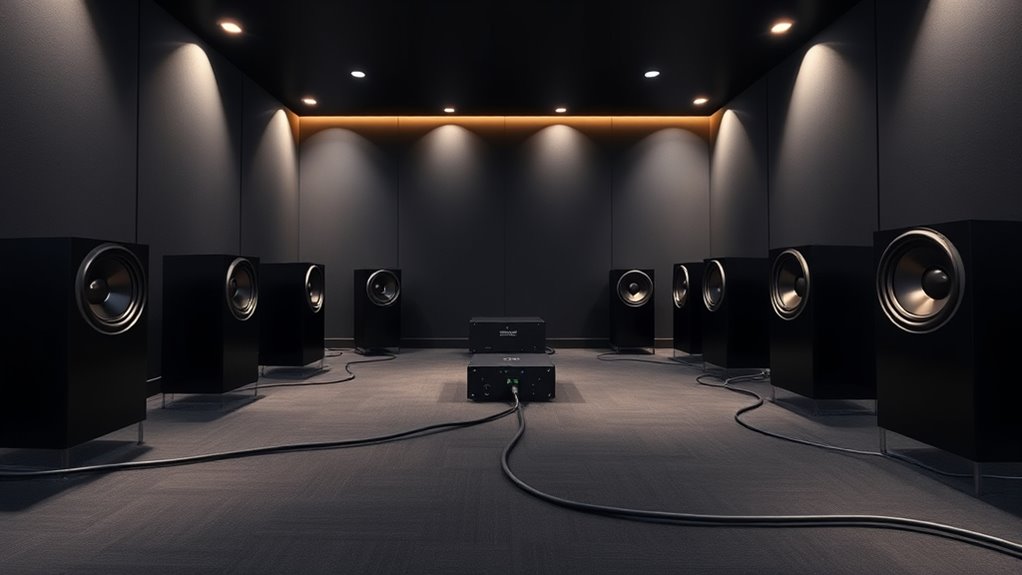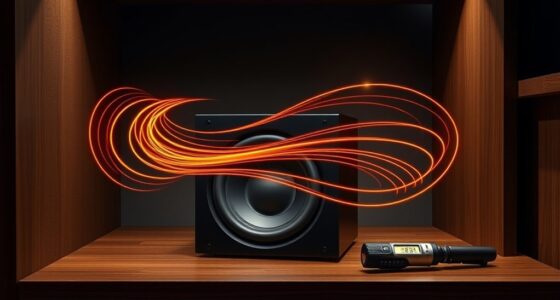Using multiple subwoofers helps you achieve a more even low-frequency response by distributing bass across your space and reducing room-induced peaks or dips. Proper placement, phase adjustments, and calibration make certain each sub works together smoothly, eliminating dead spots and boomy areas. This creates richer, more consistent bass, making your music and movies sound more immersive. If you want to learn how to optimize your setup for perfect balance, there’s more to explore.
Key Takeaways
- Distribute bass evenly by placing multiple subwoofers at different, non-symmetrical locations around the room.
- Adjust phase settings to ensure subwoofers are in sync, preventing sound wave cancellation.
- Calibrate volume levels of each subwoofer to achieve a cohesive, balanced low-end response.
- Experiment with placement using sound measurements or room correction software to identify bass issues.
- Use multiple subs to fill dead spots and reduce room-induced bass inconsistencies for a smoother sound.

Have you ever noticed your music sounds off because the bass is overpowering or too weak? If so, you’re not alone. Bass can be tricky to get just right, especially in a space where room acoustics and subwoofer placement play a significant role. When your low frequencies aren’t balanced, it can make your listening experience less immersive and even distort the details in your music or movies. The key to achieving a smooth, even low-end response is understanding how to work with multiple subwoofers effectively.
Room acoustics heavily influence how bass behaves in your space. Every room has its unique characteristics—size, shape, furniture, and even wall materials—that affect how sound waves travel and interact. These factors can cause certain bass frequencies to amplify or cancel each other out, creating uneven response patterns. To counteract this, using multiple subwoofers can help distribute bass more evenly across the room. Instead of relying on a single subwoofer that may produce dead spots or boomy areas, multiple units can work together to fill in those gaps, resulting in a more balanced sound.
Subwoofer placement is vital. You might think placing your subwoofer in the corner or against a wall is best for bass output, but this can sometimes lead to uneven distribution. Instead, experiment with positioning your subwoofers around the room. A good starting point is placing them at different locations, avoiding symmetry, and then adjusting their positions based on how the bass interacts with your space. Using tools like a sound meter or room correction software can help identify where bass is loudest or weakest, guiding you toward ideal placement.
When you set up multiple subwoofers, it’s important to consider phase alignment. If the subwoofers are out of phase, they can cancel each other’s sound waves, leading to weak bass in certain areas. Adjusting the phase controls on your subwoofers can help synchronize their output, creating a smoother low-frequency response. Additionally, calibrating the volume levels of each subwoofer ensures that no single unit dominates or is drowned out, contributing to a more cohesive sound.
In essence, balancing bass isn’t just about turning up the volume. It’s about understanding how your room’s acoustics influence sound and strategically placing multiple subwoofers to work with those characteristics. By paying attention to placement, phase, and calibration, you can achieve a richer, more consistent bass experience that transforms your listening environment into a truly immersive space. Proper subwoofer integration is crucial for optimal low-frequency performance and overall sound quality.
Frequently Asked Questions
How Many Subwoofers Are Ideal for a Medium-Sized Room?
For a medium-sized room, using two subwoofers is ideal. They help balance subwoofer power and improve room acoustics by reducing uneven bass response. With two, you create more even low-frequency coverage, minimizing dead spots and boomy areas. This setup enhances your listening experience, ensuring powerful, clear bass throughout the space. Stick with two subwoofers to optimize sound quality without overwhelming your room.
What Is the Best Placement for Multiple Subwoofers?
You should place your subwoofers at different locations around the room, avoiding corners, to achieve ideal subwoofer placement. Experiment with positioning to find spots where bass sounds even and consistent. Guarantee phase alignment by adjusting the subwoofers’ settings so they work together smoothly. Use a test tone or room correction system to fine-tune placement and phase, resulting in balanced, powerful bass throughout your space.
Do Different Brands of Subwoofers Blend Well Together?
You might find different brands of subwoofers can blend surprisingly well if you consider brand compatibility and crossover matching. Imagine a symphony where each instrument complements the others, creating harmony. When you match crossovers and guarantee similar power handling, even subwoofers from different brands can produce a seamless bass experience. Focus on tuning and placement, and you’ll enjoy a rich, balanced sound that feels natural and immersive.
How Can I Minimize Phase Issues With Multiple Subs?
To minimize phase issues with multiple subs, focus on phase alignment and signal delay adjustments. Start by setting all subs to the same phase setting, then fine-tune each one’s position and delay controls until their sound waves align seamlessly. Use a measurement microphone and calibration software to identify and correct any phase discrepancies, ensuring even low-frequency response and smooth bass integration across your space.
Is It Necessary to Calibrate Each Subwoofer Individually?
A stitch in time saves nine, and the same applies to your subwoofers. You should calibrate each subwoofer individually to guarantee ideal low-frequency response. Proper subwoofer calibration involves individual adjustment, which helps eliminate phase issues and uneven bass. By fine-tuning each sub, you get a balanced, immersive sound experience, preventing one sub from overpowering or underperforming compared to others, leading to a seamless listening experience.
Conclusion
By now, you see how multiple subwoofers can create a seamless, powerful bass experience. Proper placement and tuning guarantee even low-frequency response, making your listening space truly immersive. Isn’t it worth the effort to achieve that perfect, balanced sound? With patience and attention to detail, you’ll enjoy richer, more accurate bass that elevates your entire audio experience. So, why settle for uneven bass when you can master the art of balancing it perfectly?















